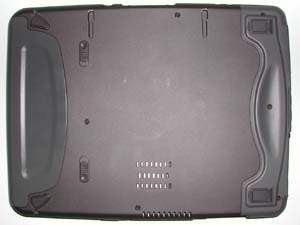The Tablet PC: An in depth look with the FIC SlateVision
by Matthew Witheiler on December 12, 2002 7:43 AM EST- Posted in
- Laptops
Although the SlateVision is a small machine, it does feature a pretty impressive port list. The ports are found, for the most part, along the unit's edges.
The front of the system is home to five separate ports. The first of these is the DC-in port. This port accepts power from the small included power brick that outputs 19V at 3.16A. To the right of the power port is the docking port. This port is set to accept either the optional keyboard or the optional docking station. In either instance, this port works in conjunction with two small grooves in the back of the system to allow the unit to stand on its own while docked.
To the right of the docking port are two headphone jacks; one for microphone in and one for headphones out. The final component on the front side of the unit is the VGA-out port. The port works via a dongle and can plug into any standard VGA monitor to drive two displays at once (the tablet and the monitor).
The right side of the unit is home to the SlateVision's communication ports. The first is an IrDA 1.1 port used for IR communication with printers, computer, or other devices. The next two ports are hidden under a small rubber piece which folds down and out of place while the ports are in use. The first of these ports is a modem jack. The second is an ethernet jack. The final item on the right side of the unit is the PCMCIA slot. The slot is able to accept one type II PCMCIA card for expansion options.
The remainder of the ports are located on the back side of the SlateVision. Here we find two USB 1.1 ports, a single unpowered 4-pin IEEE1394 port (firewire) and a lock port for securing the unit. Between the communications ports and the lock port lie the unit's power button (which slides to turn on) and reset button (which is pushed with the pen to reset the system).
The bottom of the SlateVision is home to a few other items. First off there are a few cooling holes present on the system. Because of the low power processor the SlateVision uses, the system is only passively cooled meaning that there are no internal fans. There is also a row of cooling holes on the top of the system. The location of the cooling holes correspond with the location of the system's CPU. it is around this area that we were able to measure the system's highest external temperature of 98.5 degrees Fahrenheit (37.0 degrees Celsius). This low temperature makes the SlateVision the coolest running portable system we have seen to date; pretty impressive considering it is 100% passively cooled.
On the back of the system you can also find two clip-out feet. The feet flip up at almost 90 degree angles and seem to be used to keep the unit from resting flat on a surface while in use on a table, thus allowing hot air to escape via the cooling holes. The feet are rubberized in order to minimize slipping.
The battery release buttons are also on the bottom of the system. The battery lies on the right side of the system and is easily slide out by moving both battery releases towards the center of the system.
The unit measures 11.25" x 8.5" x 1.0" and weighs in at 3.25 pounds (again, the shipping unit is said to be just under 3.0 pounds). The system is anything but big. Compared to the desktop replacements we have gotten used to, carrying around the SlateVision was a pleasure.












2 Comments
View All Comments
hemadoi - Thursday, November 15, 2018 - link
Hey! Great post on the topic, I really enjoyed with this article. I have just know about that Windows XP Tablet PC Edition maintains the full functionality of Windows XP Professional, including the advanced networking functions of the operating system.I also try to knows about MS Office and other Microsoft products at:
Thanks for sharing a valuable post!!!
samsun8521 - Wednesday, January 23, 2019 - link
That's a great web portal for me.